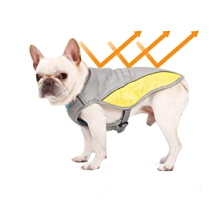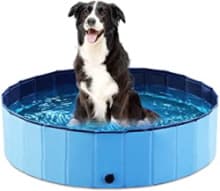Heatstroke In Dogs
What to Do If Your Pet Is Overheating
Heatstroke in dogs occurs when a dog's temperature reaches a dangerous level and he has no way to dump the heat - such as moving to a shady spot, access to water etc. For reference a dangerous level would
typically be above 103°F as opposed to a normal average range of 101 - 102.5°F.
When the temperature's rising, as well as the humidity, your pet wants you to know all about how to handle this condition because it can easily become fatal.
Not to worry - by the time you finish reading this article you're going to be hip on the subject and ready to step in if needed!
 Exhausted Dog
Exhausted DogHeatstroke, also known as hypothermia or heat exhaustion, can come on quite quickly just from a dog's normal activities and once it does, swift action is needed to bring down the temperature.
Unlike humans, Rover has few ways to dump heat and cool
off. Here are some ways you can help.
Preventing Heatstroke in Dogs
Heatwaves or just very warm summer days, are times when dogs need special attention. A few of the following pet safety measures may save your dog's life on these occasions:
- Provide a fresh water supply that cannot be knocked over
- Ask a neighbor to check and/or refresh water
if you are gone all day and he is outside.
- Provide significant shaded area away from hot concrete
- Delay unnecessary activity, such as walks, until sundown
- No car trips with the dog on warm days. Cars heat up quickly even if parked in the shade.
- Never restrict a dog's terrain by using Pet Tie Outs
In short, to avoid heatstroke a dog needs to be hydrated, shaded and cooled off
by sufficient ventilation.
Typically the biggest threat to heatstroke for pets is when they are left in cars where temperatures can rise very quickly. You've no doubt read many stories, as I have, of dogs trapped in hot cars with sad outcomes - and not just in summer.
The Symptoms of Canine Heatstroke
Being aware of these signs of heatstroke in dogs will enable you to act quickly if you spot your dog or someone else's dog in danger:
- Rapid panting and restless behavior
- Abundantly salivating
- Elevated heart rate (and temperature if you can obtain it)
- Bright red lips and tongue
- Vomiting
- Disorientation - not responding to you
Some more severe symptoms would include:
- Obvious weakness or collapse.
- Seizures or unconsciousness.
In general, an appearance of a thirsty dog in great distress.
Another factor to note is that some breeds are more at risk for heatstroke due to having
flat faces and short noses like Bulldogs and Pugs
- often referred to as Brachycephalic breeds. These breeds typically have breathing difficulties which can be more affected by hot weather..
Also in the higher risk category are
senior dogs, puppies, and those with certain health conditions such as heart disease or over weight issues.
Hopefully, after reading this article and keeping it for reference, your dog will have all the protection it needs in hot weather.
If you have ever hiked the Grand Canyon on a hot day as I once did, you may have felt something close to heatstoke and definitely wouldn't wish it on your dog!

Treatment For Heatstroke
- Act quickly to get your dog to a cool place.
- Get the temperature down by:
having the dog stand in some cool water for a few minutes at a time.
- Wetting him down gradually with a hose or wet towels, starting at the feet and working up to the armpits and rest of the body.
- Optionally, use a fan if available and/or necessary, until the distress starts to subside.
- Provide water in small doses so that it is not regurgitated.
If your dog's condition looks severe and he looks very weak take him to your vet immediately.
Even if the condition appears to be improving, heatstroke can damage internal organs, so the best cause of action is still to get your precious pet checked out by your veterinarian and not take any chances.
Products To Keep Dogs Cool
Here are a few summer time products you won't want your furry friend to be without during the hot days of the season. Having access to some of these items may save your dog's life.
When the weather heats up, humans have many ways to cool off and may not necessarily feel it's too hot for the family dog until there are signs of his distress.
Consider these items as part of your dog's first aid supplies and you'll always be able to help him/her on a hot day if needed.
Recommended Reading
To help you be more confident as a dog owner and learn to recognize various dog health conditions, I also suggest getting a copy of Dr. Pitcairn's Complete Guide to Natural Health for Dogs & Cats.
Written by a renowned veterinary authority, this reference contains invaluable information about using natural remedies as well as mainstream solutions for dog problems.
Before You Go...
If you like the content of this page, as well as others on my site, please give it some love by clicking on the heart in the lower right hand corner. This helps me to keep providing enjoyable and useful content.
Thank you.
Other Health Related Pages








